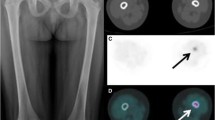Abstract
Background
In Langerhans cell histiocytosis (LCH), FDG PET demonstrates active disease in bone. Other imaging modalities show the effects of bone destruction by LCH.
Objective
To evaluate a selective CT method for reducing effective dose from FDG PET/CT in LCH, using whole-body modified attenuation correction CT at extremely low exposure settings, with repeat selective limited-volume CT at typical localization settings.
Materials and methods
Fifty-one PET/CT scans were performed in 23 LCH patients, median patient age 8.5 years (range: 1–25 years). Thirty-four were performed with modified attenuation correction CT settings, with bed positions (excluding head and neck) repeated at localization CT settings in regions with abnormal or difficult to interpret PET findings.
Results
Of 34 modified attenuation correction PET/CT scans, 10 required repeat localization CT of 1 to 3 bed positions (total: 17 bed positions). Lytic bone lesions were easily recognized at modified attenuation correction settings. Calculated average effective dose for the 34 whole-body CT scans at modified attenuation correction settings was 1.65 mSv. Average effective dose per patient for repeat imaging of 17 bed positions at localization settings was 1.19 mSv. Average total effective dose from CT for all 34 scans performed at the modified attenuation correction CT settings, including the 10 repeat localization CT scans, was 2.0 mSv. High-quality PET scans were consistently obtained with reduced FDG-administered activities of 3.7 MBq/kg (0.10 mCi/kg). In active LCH, abnormal FDG uptake was seen in all lytic bone lesions ≥9 mm, including cranial vault lesions.
Conclusion
Substantial reduction in effective dose is possible using selective CT techniques for FDG PET/CT.


Similar content being viewed by others
References
Anton CG (2012) Langerhans cell histiocytosis. In: Donnelly LF, Jones CG, O’Hara SM, Anton CG et al (eds) Diagnostic imaging: pediatrics, vol 6, 2nd edn. Amirsys, Salt Lake City, pp 120–123
Binkovitz LA, Olshefski RS, Adler BH (2003) Coincidence FDG-PET in the evaluation of Langerhans’ cell histiocytosis: preliminary findings. Pediatr Radiol 33:598–602
Kaste SC, Rodriguez-Galindo C, McCarville ME et al (2007) PET-CT in pediatric Langerhans cell histiocytosis. Pediatr Radiol 37:615–622
Phillips M, Allen C, Gerson P et al (2009) Comparison of FDG-PET scans to conventional radiography and bone scans in management of Langerhans cell histiocytosis. Pediatr Blood Cancer 52:97–101
The French Langerhans’ Cell Histiocytosis Study Group (1996) A multicentre retrospective survey of Langerhans’ cell histiocytosis: 348 cases observed between 1983 and 1993. Arch Dis Child 75:17–24
Bernstrand C, Sandstedt B, Ahström L et al (2005) Long-term follow-up of Langerhans cell histiocytosis: 39 years’ experience at a single centre. Acta Paediatr 94:1073–1084
Fahey FH, Palmer MR, Strauss KJ et al (2007) Dosimetry and adequacy of CT-based attenuation correction for pediatric PET: phantom study. Radiology 243:96–104, Erratum in: Radiology 2008 248:1085
Stabin MG, Gelfand MJ (1998) Dosimetry of pediatric nuclear medicine procedures. Q J Nucl Med 42:93–112
ImPACT Software. London, UK. http://www.impactscan.org/. Accessed 3 June 2014
Alessio AM, Kinahan PE, Manchanda V et al (2009) Weight-based, low-dose pediatric whole-body PET/CT protocols. J Nucl Med 50:1570–1577
Lee HJ, Ahn BC, Lee SW et al (2012) The usefulness of F-18 fluorodeoxyglucose positron emission tomography/computed tomography in patients with Langerhans cell histiocytosis. Ann Nucl Med 26:730–737
Mueller WP, Melzer HI, Schmid I et al (2013) The diagnostic value of 18F-FDG PET and MRI in paediatric histiocytosis. Eur J Nucl Med Mol Imaging 40:356–363
Gelfand MJ, Parisi MT, Treves ST (2010) Pediatric radiopharmaceutical administered doses: 2010 North American consensus guidelines. J Nucl Med 52:318–322
Gelfand M, Huang J, Sharp S (2011) PET with selective CT at follow-up in pediatric and adolescent patients with lymphoma (abstract). Pediatr Radiol 41:S270–S271
Conflicts of interest
None
Author information
Authors and Affiliations
Corresponding author
Rights and permissions
About this article
Cite this article
Gelfand, M.J., Sharp, S.E. & Palumbo, J.S. Selective CT for PET/CT: dose reduction in Langerhans cell histiocytosis. Pediatr Radiol 45, 81–85 (2015). https://doi.org/10.1007/s00247-014-3103-0
Received:
Revised:
Accepted:
Published:
Issue Date:
DOI: https://doi.org/10.1007/s00247-014-3103-0




